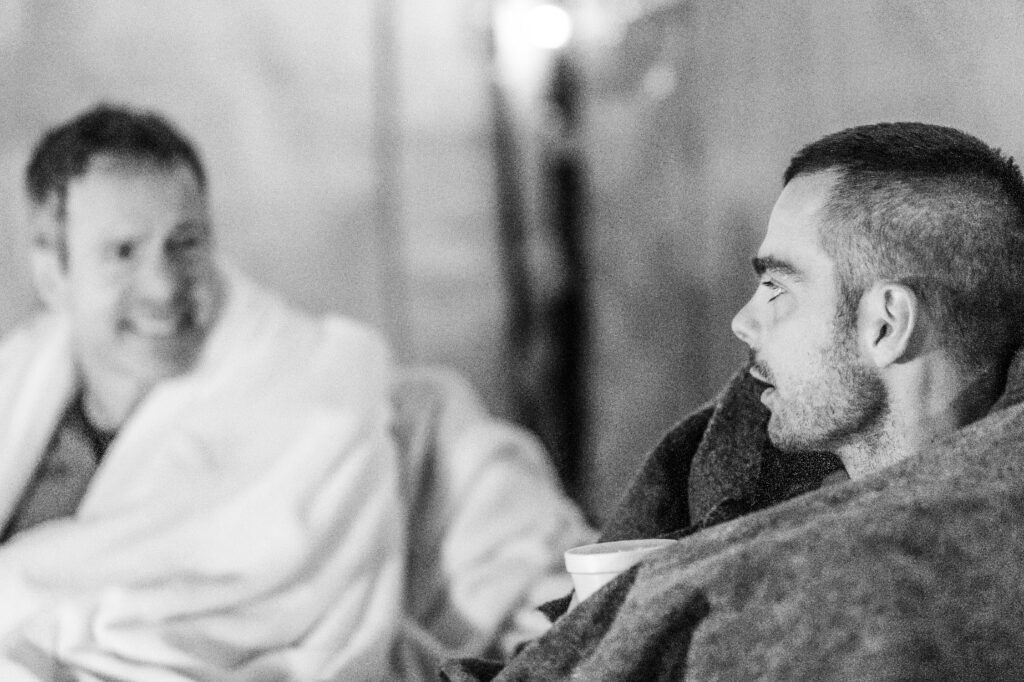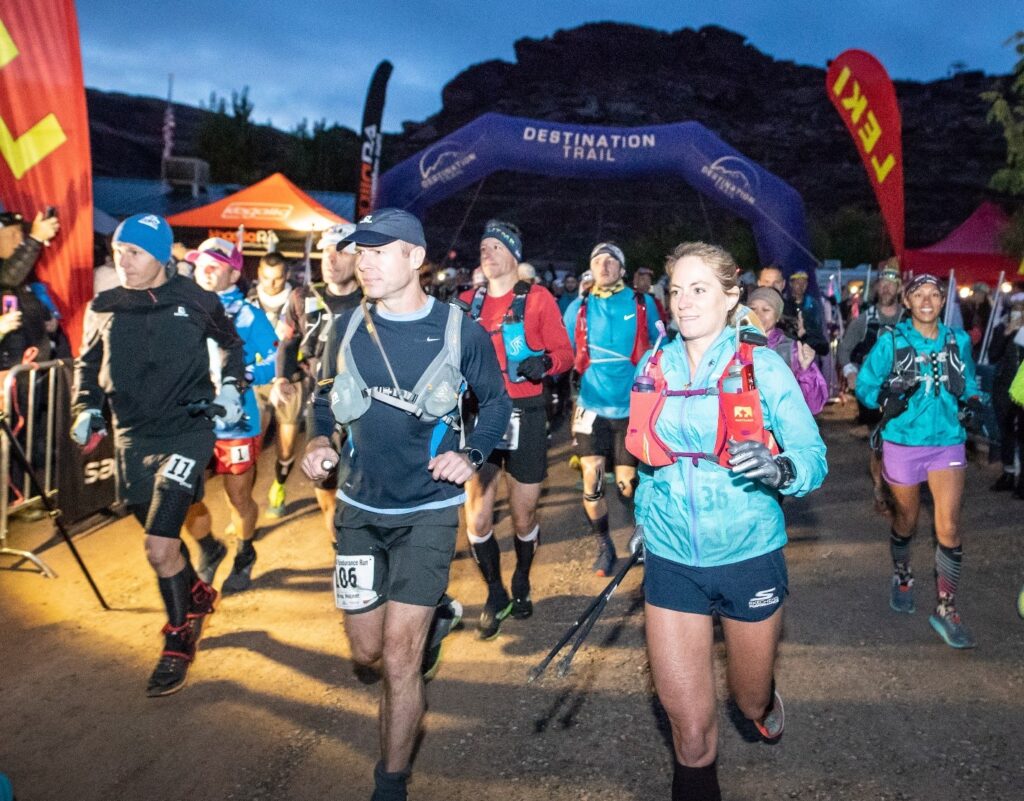
Arrival
It was October 11, 2018, the afternoon before the race. I’d just finished the check-in process. I’d retrieved my drop bags from my car, and was carrying them to the designated area. That’s when I saw Jovica. He was up a small slope from me, standing where all 150 of the runners would soon gather to hear the pre-race briefing.
Jovica and I were too far apart for me to say anything. I could have shouted, but it seemed like that would have been obnoxious since we didn’t know each other very well. Instead, I waved. He waved back. His face was unmoved. Stoic.
I wasn’t sure how to read his lack of an expression. We’d been the first and second place competitors for the first 140 miles of the previous year’s Tahoe 200 race, so I thought that maybe he viewed me as an opponent rather than as a friend. I wanted to respect his feelings, so I decided I should just give him his space.
I finished the short walk to the drop bag area without another glance up.
I didn’t see Jovica again until we found ourselves standing side by side near the starting line the next morning in the gradually increasing light of the rising sun. Still trying to respect his space, I remained silent. We stood there for several long moments before he broke the ice by saying hi. We exchanged well-wishes for the coming race, then the horn blew and the race began.
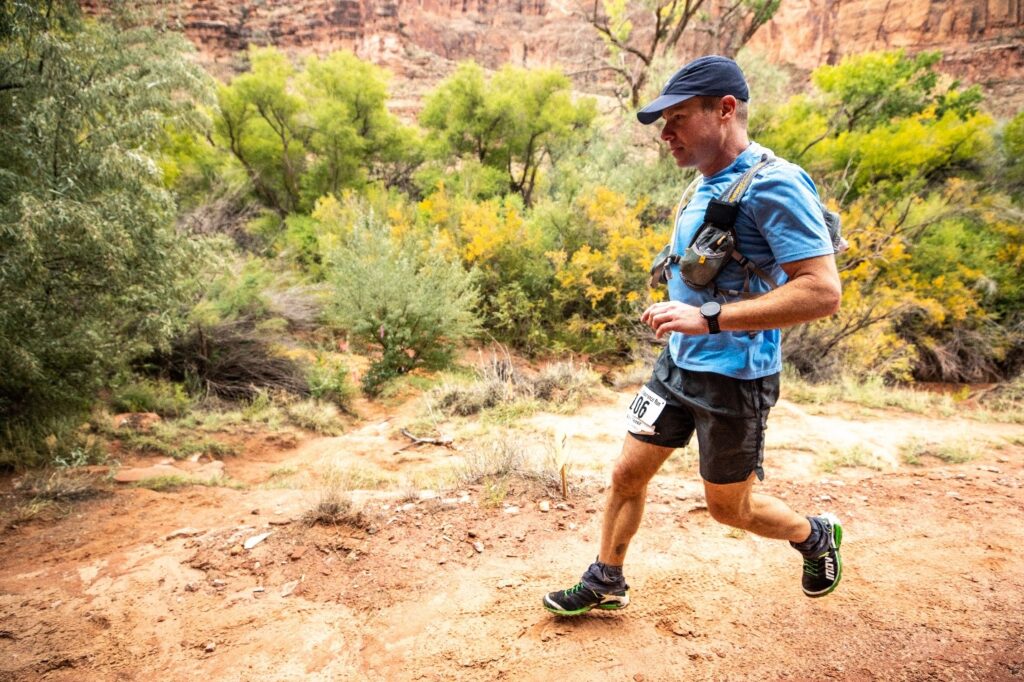
Connecting. Start to Breaking Bad. 57.3 miles. Mile 0 to 57.3
A few of us broke out ahead from the start, running just a little faster than was necessary for a race this long. I knew we’d be passing through a corner of Moab before turning onto a winding, single-track trail which included a steep, technical ascent to the top of a high mesa. What I didn’t want was to be caught in the midst of a large pack of runners as we moved along that single-track trail. It was better to expend a little extra energy now to get ahead of the pack rather than wasting energy trying to move through the mass of runners later when we’d all be limited by the confines of a narrow trail. Jovica must have had similar thoughts, because he was up with the lead group a few paces in front of me.
Once atop the mesa, the trail went through a valley before crossing several miles of slickrock. Jovica, Colin Marz and I ran together across the slickrock, chatting idly and working together to navigate through a couple sections where the route was unclear. At the Amasa aid station, mile 18, I had to transfer some fruit squeeze packs from my drop bag to my hydration pack, so Jovica made it through the aid station faster than I did. But I was less than a mile outside the aid station when I found myself again running with him.
At this point, on the trail to Hurrah Pass aid station, Piotr Hercog of Poland was in the lead. Jovica, Colin and I were running together in a collective second through fourth place. Ryan Wagner rounded out the top five, and was trailing close on our heels. Ryan had been a strong contender at Bigfoot 200 earlier in the year, so, like Jovica, he was on my radar as a top competitor at Moab.
Hurrah Pass was an eight-minute stop for me, and then I was on my way just a couple minutes behind Jovica. I caught up to him, and we ran the next, relatively flat 25-mile section at a reasonable, steady pace. Colin Marz dropped back sometime during that section, but there were several other runners not far behind us. For some reason, Jovica and I stayed together, and the relationship started to feel less like a competition and more like a partnership.
The only time Jovica and I deviated from our steady pace was after we were passed by Eric Deshaies, of Canada. We made a brief effort to not let him get too far ahead of us, but a couple miles later we chastised ourselves for being sucked into altering our pace. A small lead in the early part of a race as long as Moab was meaningless. There was a silent agreement that we wouldn’t make that mistake again.
It was at the Breaking Bad aid station, mile 57, that Jovica vomited for the first time. It would happen to him about five more times before the day was over. Every time, without fail, he’d pause momentarily after vomiting, then he’d walk forty or fifty meters, and then he’d start running again. There was no stopping him.
Our shared running patterns formed during these early miles of the race. Unless the trail was wide, one of us would be in the lead, and the other would follow close behind. If the lead runner started to slow down, the runner in back would pass and re-establish the pace. If one of us had to stop to adjust something in his pack, the other would sometimes stop alongside the first, but more often would just slow to a walk until the other caught up. None of this was ever spoken about or part of a plan. These patterns just developed organically.
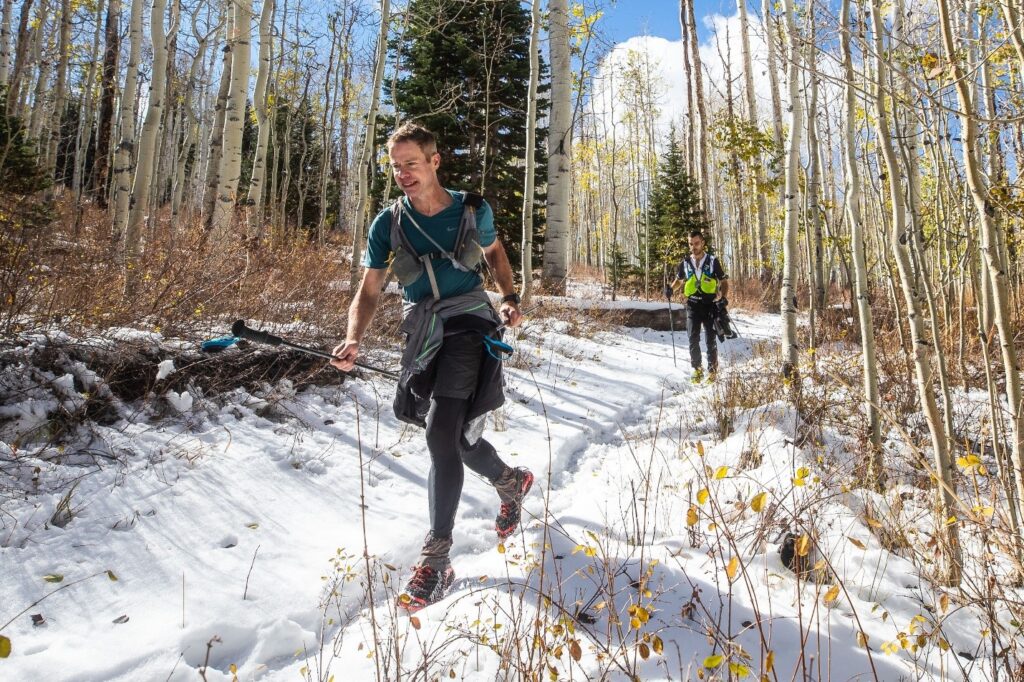
Acknowledging Our Weakness. Breaking Bad to Shay Mountain. 63.7 miles. Mile 57.3 to 121.0
Jovica is an experienced, successful 31-year old runner from Serbia who has run some of the world’s toughest races. When he’s not out on the trails, he’s part of an elite Serbian counterterrorism force based out of Belgrade. Though technically a police force, his unit is closer to a military organization. I graduated from West Point and then served as an officer in various tank battalions for an additional seven years before leaving the Army and shifting to a career in manufacturing and distribution management. I have to believe this common military touchpoint shaped the discipline which seemed to be the root of our similar approaches to racing.
We hit the Hamburger Rock aid station, mile 74, at 10 PM. I had only one crew member, Annie, and Hamburger Rock was the first stop where I would see her. She was ready with a chair and a blanket set out for me. A hydration pack lay nearby, already loaded with fluids, fruit squeeze packs and everything else that I would need for the coming miles. I drank orange juice and ate some potato soup Annie had prepared for me. In races as long as Moab, my stomach tends to react better to bland food, so I had actually done a taste test of potato soups earlier in the year. The purpose of the test was to find the blandest potato soup available. And the winner? Well, if you’re looking for some utterly tasteless soup to serve to people you don’t like, I give Walmart’s Great Value cream of potato condensed soup a very high recommendation.
Eric Deshaies arrived at Hamburger Rock at about the same time as Jovica and I did, but Eric got back on the trail quickly, whereas we took our time. Ryan Wagner and Sean Nakamura arrived after us, but they departed before us as well. We passed Sean relatively quickly after leaving Hamburger Rock, but Ryan and Eric stayed ahead of us for a while. Sean was another tough 200-mile competitor who, in 2017, had won Tahoe 200 and had placed as the top male finisher at Moab 240.
By the time we hit the Island aid station at mile 87, Jovica’s stomach had settled, and it had been several hours since he’d last thrown up. We sat down in a pair of camping chairs to refuel and rest. After a few cups of Coke, I decided to try some of the aid station’s soup. Unfortunately, a couple swallows of the salty broth pushed my stomach over the edge, and it was my turn to vomit. Regardless, we were moving again within ten minutes of arriving at the aid station. I decided to back off the salt for a while. I stopped taking salt tablets, and, at the next aid station, I even switched to filling my pack with water instead of the electrolyte beverages I’d been filling it with all day. This worked for me, and I didn’t have any real stomach issues for the rest of the race.
The first night was easy to get through without falling victim to sleepiness. My body was used to this level of sleep deprivation from the 100-mile and 200-mile races that I’d run in the preceding years, and I no longer even felt the urge to sleep during the first night of a race. We passed Eric just before Bridger Jack aid station, about 27 miles after he’d passed us. Regardless, all of us—Ryan, Sean, Eric, Jovica and I—remained within close enough proximity to one another that it didn’t really matter who was in front of whom at this point.
We hit Bridger Jack aid station, mile 102, just after 5 AM Saturday morning, which meant we’d done our first 100 miles in 22 hours. This was a little ahead of my planned time, so I felt pretty good about how we were progressing. However, in what was becoming a trend, Eric and Sean left the aid station ahead of us.
The route out of Bridger begins on a dirt road that winds slowly down the mountain. Several miles along this road I realized I hadn’t seen a course marker in a while. I mentioned it to Jovica, but we decided to go a little further because neither of us had seen anywhere to turn off the road since the aid station, so it seemed impossible that we could have missed a turn.
Then we saw Eric backtracking up the road toward us. This was not a good sign. Sure enough, when he got to us, he said he’d checked his GPS, and we’d all somehow missed the turnoff to the trail. We turned around and ran back up the dirt road a couple miles, looking for the trail as we ran, but we saw nothing. We eventually bumped into Ryan and a couple more runners coming down the road from the aid station who had also missed the invisible turn. Working off the maps on two of the runners’ cell phones, we searched together for a few minutes, but couldn’t find the turn. Then someone suggested going back the mile or two to the aid station so we could ask the volunteers if they knew where the turnoff was. I reminded them that the volunteers might not know where the turn was either.
In an effort to stave off this go back to the aid station line of thought, I turned on my phone and opened the GPS app into which I’d downloaded the course route. I noticed that the GPS tracks were a perfectly straight line through this area despite the fact that the road itself was smoothly winding. This meant that when the tracks for this portion of the trail were recorded, the GPS had lost signal. The inaccurate GPS track was a part of the confusion. But I also found a point of intersection between the trail we wanted and a point on the road where the recorded path appeared to be correct. This was where we had to go, and it was very close. I made a quick appeal to the growing cluster of lost runners, then headed toward that point of intersection. The group followed, and I found a hidden, unmarked turn which was our trail.
Fifty feet past the turn was a lone marker that couldn’t be seen unless someone had already found the hidden turn and started to walk down the trail. We moved the marker to a dead limb right at the intersection of the road and the trail. It wasn’t a great spot for the marker, but it was significantly better than where it had been before, and it was the best we could do with only a single marker. Hopefully, the runners arriving later would see it.
The trail dropped us into a dry riverbed, and soon we were beginning the long climb up Shay Mountain. There were six or seven of us in the same general vicinity at this point, but shortly after the ascent began, Jovica, Ryan and I broke off as a lead group to complete the ascent. All three of us would arrive at Shay Mountain aid station together.
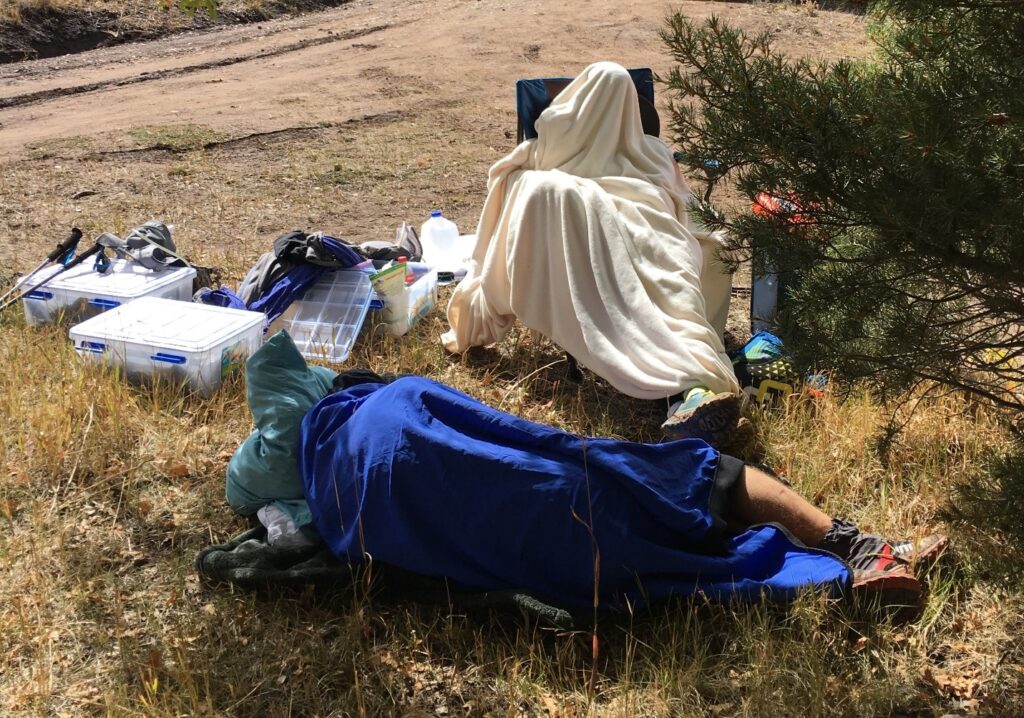
Mitigating Our Weakness. Shay Mountain to Road 46. 45.7 miles. Mile 121.0 to 166.7
It was 3:30 PM on Saturday when we arrived at Shay Mountain. Annie was waiting for Jovica and me, and Ryan’s mom was there for him. Piotr, we soon learned, had departed the aid station about 30 minutes before we arrived. I ate some real food, and I curled up on a blanket in the sun for several minutes. I didn’t actually fall asleep, but it felt good to close my eyes.
Sean Nakamura arrived at the aid station after us, but he refueled quickly and departed before us. This had definitely become a trend that needed to stop.
Jovica and I passed Sean within the first two or three miles of leaving the aid station. After we were a few hundred meters ahead of him, I commented to Jovica that Sean’s running style seemed to be to maintain a slightly slower pace, but to blow through the aid stations without wasting a moment. We needed to be quick at the next aid station so we didn’t enable Sean’s tactic. Jovica agreed. When we arrived at Dry Valley aid station at mile 139, we’d already established a specific time goal for our stop, and we departed right on the mark. As it turned out, after passing Sean back at mile 123, we wouldn’t see another runner for the remaining 117 miles of the race.
For all the facets of racing style that Jovica and I shared, there was one aspect that was almost comically different. It played itself out during several segments of the race. The latter portion of the route to the Road 46 aid station was one such segment. We were 160 miles into the race at that point. The conversation started the same way it always did.
“I think we’re almost to the aid station,” Jovica said.
We were ascending a gentle slope that seemed to have no end. I remained silent as I checked my watch to see how long we’d been running since the previous aid station. I made an assumption about our pace, multiplied it by the amount of time we’d been running, and then said, “I think we’ve got a few more miles to go.”
“No, I really think we’re getting close.”
I hesitated, unsure Jovica wanted to hear this next bit. “We’d need to be going about two minutes per mile faster than I think we’ve been running in order to be close. I think we’ve still got another five miles to go.”
Silence. We kept running.
Jovica and I both ran from the heart. We shared a passion for being out on the trail, we shared a passion for facing a daunting challenge, and we shared a passion for persevering through pain and exhaustion. There was discipline to our pace, and there was joy in the experience. But somewhere in Jovica was the need to believe that a respite, no matter how brief, was near. And somewhere in me was a need to try to understand exactly how far away that respite was. I never made those distance calculations unless Jovica brought up the topic, but, if he brought it up, I had to figure out how far the aid station might be. We never argued about who was right. It was always just two people sharing their perspectives. We always kept moving together. Side by side or one of us in front. Together.
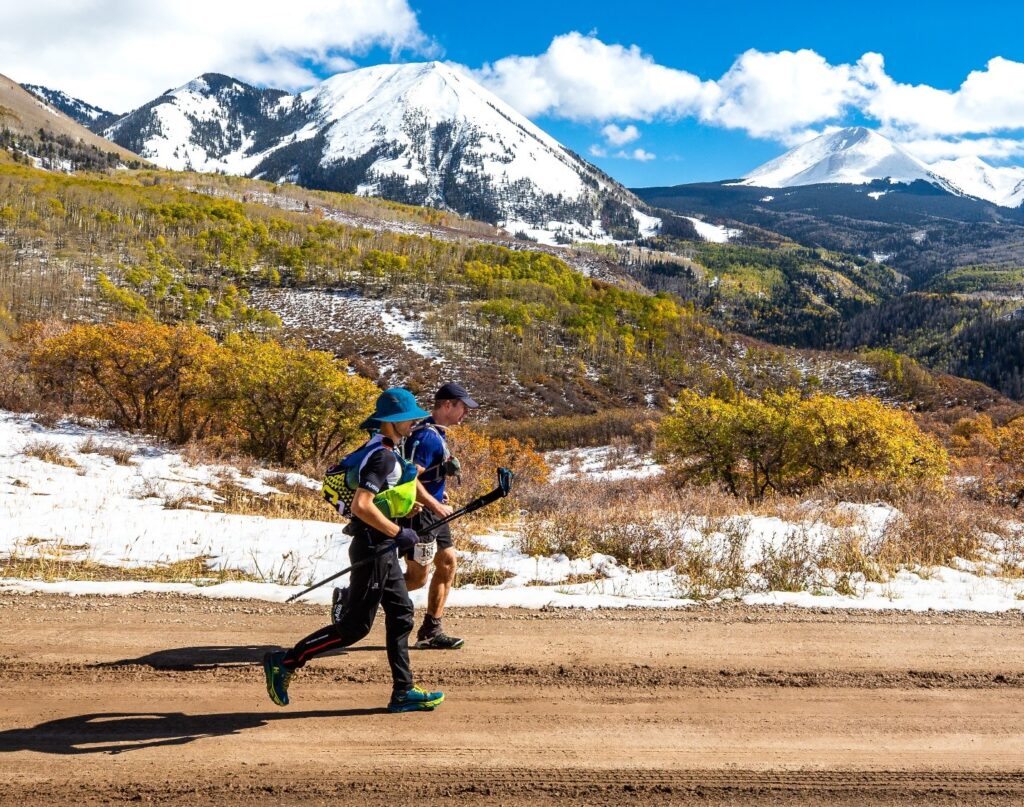
A Pacer Through the Sleepy Hours. Road 46 to Porcupine Rim. 57.0 miles. Mile 166.7 to 223.7
At the Road 46 aid station, Jovica and I met up with Kerry Ward. Kerry is an ultrarunner I’d run with throughout a long stretch of Bigfoot 200 in 2015. On Facebook a couple weeks before the race, Jovica had made an appeal to see if anyone was willing to pace him for any portion of Moab. Quite generously, Kerry had answered that call, and had flown out to meet Jovica and pace him for 53 of the last 73 miles of the race. With Jovica and I running together, I would get the benefit of a pacer for those miles, and I’d get to spend some time with an old running friend. Kerry would run with us from Road 46 to Oowah Lake, then he’d take a break while we ran the 20 miles from Oowah Lake to Porcupine Rim so he could be fresh for our last 16-mile stretch.
The trail out of Road 46 is a steep, rocky ascent. Kerry led the charge, and had us moving along at a good pace until, a mile or two into the climb, he stopped abruptly to announce that we were off course. Jovica and I started looking for course markers while Kerry took off, GPS in hand, to find the trail. Kerry found the trail a few minutes later, and we all started moving forward again.
If there was one thing that characterized my experience during the fifteen miles from Road 46 to the Pole Canyon aid station, it would be extreme sleep deprivation. I fell into step behind Kerry and Jovica, my brain shut down, and I just moved along through a vague nightscape of rocky trails and stunted trees. I’d known the second night would not be as easy to get through as the first night had been. Not only had the endless hours of running worn on me, but I hadn’t gotten much sleep the night before the race. I’d fallen asleep at 8 PM on Thursday night—which would have been fantastic if I’d slept all the way until the morning—but I’d woken up at 12:30 AM and I hadn’t been able to fall back asleep. So, by the time the race started at 7 AM on Friday, I’d already been up for 6 ½ hours with only 4 ½ hours of sleep.
Kerry and Jovica chatted throughout this section. I would sometimes try to tune in to their conversation as a means to stay alert, but it only worked so well, and I’d eventually slip back into a semi-somnambulant state. At one point, I made a concerted effort to wake myself by engaging in the conversation. That helped for a little while before, inevitably, I fell silent as I became sleepy again. Kerry—ever the dedicated pacer—then made an obvious and reasonably-successful effort to give me something to focus on by telling the longest and most wandering story imaginable. The story centered on a friend of his who had recently run his first 100-mile race. It could easily have been a five-minute tale, but Kerry took the narrative down every rabbit hole and into every loosely tangential detail possible. I found myself focusing alternately on the story itself and the fact that Kerry was clearly stretching it out for my benefit.
When we arrived at Pole Canyon aid station, there was not a single sign of life. The lamps were out, the stoves were off, and the personal tents of the volunteers were all zipped up. I spotted two blankets, grabbed them, and immediately began looking for a place on the ground to lie down that wasn’t covered with jagged rocks. Jovica dropped into a camping chair and wrapped a blanket over his shoulders while Kerry began rummaging through the aid station supplies for food. Moments later, a powerful gust of wind flipped the aid station canopy and its poles into the air. The entire assembly flew over Jovica’s and Kerry’s heads and into the nearby trees. It startled all of us, and it woke up the volunteers who clambered sleepily out of their tents to begin reassembling the aid station and firing up the stove.
Not long after we departed Pole Canyon, I began coming out of my sleepy state, and, as the sun rose above the horizon, we started making better time. There was a memorable climb up a steep cow trail that required trekking poles and a lot of determination. Even the mindless, free-grazing cows in the area were smart enough to use this particular trail solely for descents. It was only the foolish, ultrarunning humans who were dumb enough to ascend it.
The last several miles before the Oowah Lake aid station consisted of snow-covered, rolling hills. With each step, our feet post-holed through the thin crust of snow and into the deeper powder beneath. It was slow-going, for the most part, aside from a few short downhill sections where momentum carried us more easily through the snowpack.
At Oowah Lake, I took the time to eat an entire cheeseburger and to close my eyes for a few minutes. Jovica refueled and swapped his grimy socks for a fresh pair that Annie dug out of my gear in the back of the truck. Eventually, we got moving.
The route from Oowah Lake to Porcupine Rim began with a single-track ascent before intersecting a dirt road that would take us the rest of the way to Porcupine Rim. We sped up once we hit the road, and, for the first time in the race, I pulled out my phone to see how far back the next runner was. Earlier, we had made a decision that we weren’t going to attempt to catch Piotr, the Polish runner in first place, but we wanted to make sure Ryan, the next runner, had no hope of catching us.
We were making good time on the road at the same time Ryan would have been hitting the pace-slowing snow on the trail to Oowah Lake, so, every time I checked my phone, we had opened a wider gap between Ryan and us. When I checked the gap for the last time, Ryan was almost 20 miles behind us, so I finally put the tracker away for good. Of course, not long after I put the tracker away, I heard….
“I think we’re getting close to the aid station.”
Smiling, I glanced at my watch and began making calculations.
Also smiling, Jovica just shook his head.
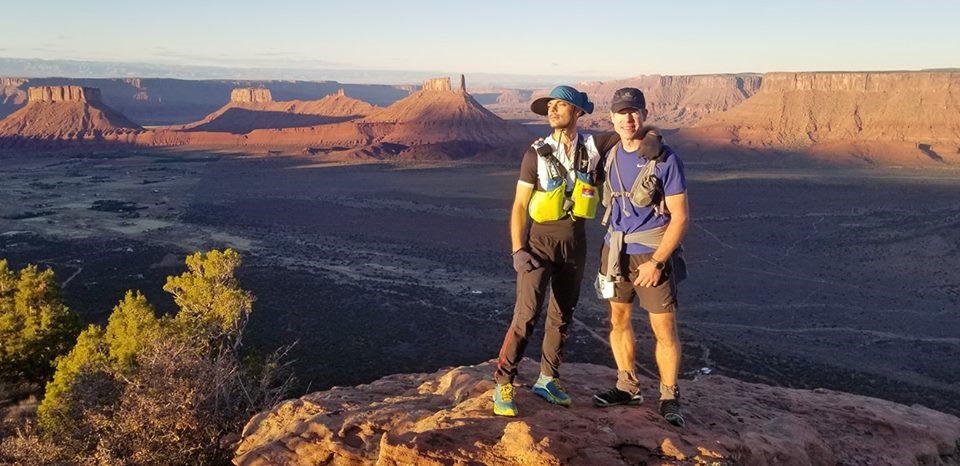
Finishing Together. Porcupine Rim to Finish. 16.3 miles. Mile 223.7 to 240.0
When we arrived at Porcupine aid station, we decided to take our time and enjoy both our stop at the aid station and the subsequent sixteen miles without the ordinary pressure of a race. The race was all but done. Barring an injury, our finishing places were assured, so it seemed like a good time to bask in the joy of a hard-fought battle drawing to a close. Kerry rejoined us at Porcupine Rim, and Annie was there as well. We laughed and chatted with each other and with the aid station volunteers. Twenty-three minutes after arriving at Porcupine Rim aid station, we were on our way.
For two former competitors who had never made a plan to run the race together, it was surprising how natural it felt to have essentially run the last 224 miles together. About four miles into this final section, Kerry asked how we wanted to handle the finish. Was one of us going to run across the line ahead of the other? Would we finish side-by side? There were eighteen countries represented in the race, and, from past experience, Kerry and I knew that the race director always lined the chute to the finish line with the flags of all countries participating. With the sun setting behind one of the distant mesas, we decided that our multi-national team would each carry the flag of our country as we crossed the finish line together.
We were descending the technical, rocky path that is Porcupine Rim trail. I’d run Porcupine Rim a couple times a year earlier. I loved the rocky beauty of that trail, and I respected its ankle-rolling nature. It can be a fast but challenging trail to run in the daylight. At night, with the play of shadows on the uneven rock surfaces, the trail becomes a little more difficult but can be almost as fast.
When the sunlight had dimmed enough that I started to have difficulty seeing, I stopped, took off my hydration pack, and opened the rear zipper pouch to take out my flashlight and my headlamp. I have terrible night vision. So, in races, I always have two sources of light. The first is an ordinary headlamp. The second is a small but extremely powerful flashlight. If I put my flashlight on its highest setting, the handle actually becomes warm to the touch, but the bright beam will turn a swath of the night into day.
The pouch contained a pair of fruit squeeze packs, but no flashlight, and no headlamp.
This wasn’t a problem, because I was certain my flashlight and headlamp were tucked into another of the pouches. I checked the front of the pack. Nothing. I checked the rear pouch again. Still nothing. I unzipped the pouch that held the water bladder. It too was empty. There was a brief moment of remorse, before I quickly decided that not having a light source as night fell was just something to deal with.
Ultimately, the mistake was solely my fault. The people who crew me are experienced, and I accept the risk that there might still be an occasional mistake. Especially late in the race when my brain often loses its sharpness from serious sleep deprivation, I’m the last person who should be ensuring the contents of my pack. It’s really the same approach taken by every race car driver…you never see the driver hopping out of the vehicle to make sure the pit crew put all the tires on properly. For the sake of efficiency, the driver trusts his crew, and he accepts the inherent risk involved with not checking it himself.
By now, Jovica and Kerry had put on their own headlamps and could see something was wrong.
“I don’t have a light,” I said. “I have terrible night vision. I’m going to be moving slowly.”
There wasn’t even a moment of hesitation before Jovica said, “You can use mine. I have good night vision. I’ll run between the two of you.”
I asked Jovica if he really wanted to give me his light, but I already knew the answer. In 230 miles of running, I’d gotten to know the kind of person he was.
Kerry ended up running beside Jovica while I ran directly behind him with the borrowed headlamp aimed at his feet. We ran at a pretty solid pace considering one of the three of us wasn’t wearing a headlamp. How Jovica was able to sustain that pace in secondhand light across rocky, uneven ground is beyond me. And how he arrived at the decision to give me his headlamp is even further beyond me. Somewhere through the miles and the hardship, he had become a true friend.
Toward the end of the descent, Kerry remembered that he had a flashlight tucked into his pack. He gave me the flashlight and I gave Jovica the headlamp. A mile later, we passed through a culvert and onto the bike path that we’d follow for the last three miles to the finish line. We paralleled the Colorado River for most of those three miles, and then passed beneath a highway. From there it was only a few minutes before we saw the lights of our final stop.
Kerry ran ahead as we approached the finish line. He grabbed the Serbian flag for Jovica, and the US flag for me. He handed us our flags and then, together, we walked across that line.
We finished in 62 hours, 40 minutes and 49 seconds. The winner, Piotr, had finished 2 ½ hours ahead of us. The next finisher, Ryan, would finish 9 hours behind us.
Jovica and I sat at the finish line enjoying the warmth of a propane heater and talking to the people around us. I don’t know how many words we said to each other as we sat in the comfort of the tent and the heater. There might have been many words, or there might have been none. I was too tired then to remember it now. It doesn’t matter. We shared a 240-mile adventure. We shared 240 miles of pain. We shared 240 miles of learning who each other was when we were stripped down to the bone, when every shred of pretense was torn away and all that was left was who we truly were.
We’ll share another adventure somewhere down the trail of our lives. Of that I’m certain.
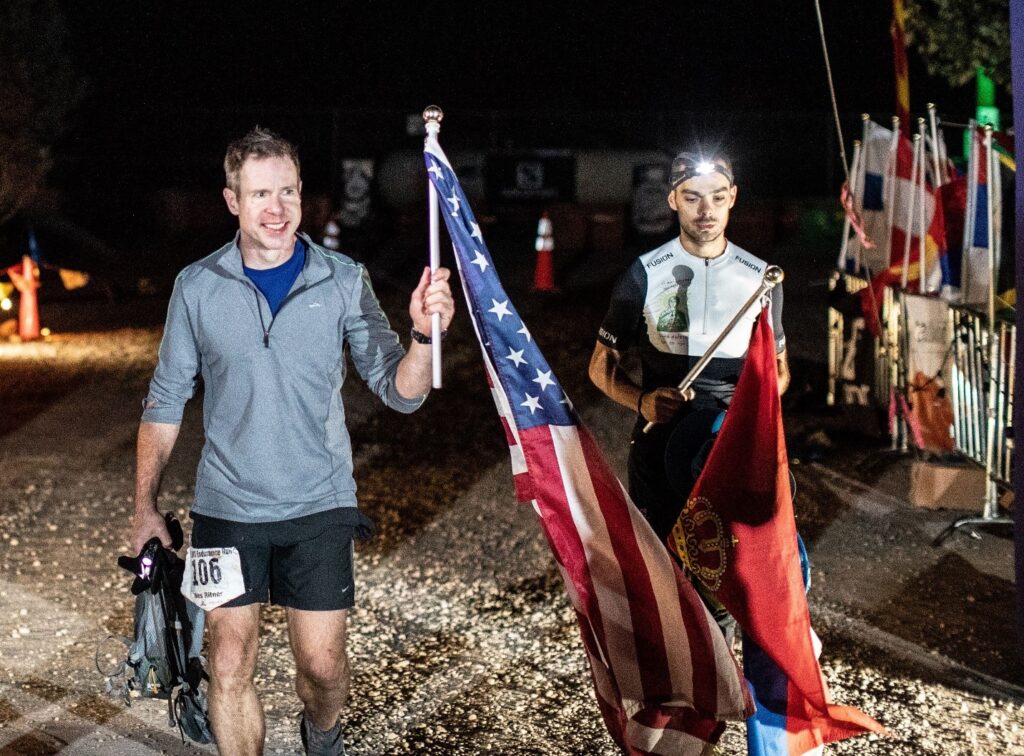
Epilogue
Sunday night, in my hotel room after the race, I woke up three or four times. Each of those times, I woke up in sheets soaked by my own sweat. The dream I’d been having was the same every time. I was running on a trail covered with fist-sized, jagged rocks. It was very much like parts of the trail between Pole Canyon and Oowah Lake. I was running alone. I saw not a single person during the entire dream. I was just running and running and running.
Each time, after waking up, I’d drink a cup of water to replace what I’d just sweated onto the sheets. I’d crawl back into bed, but I’d shift a fraction of a meter to one side to avoid laying down between the wet, cold sheets I’d left behind. This cycle repeated itself for four consecutive nights. There were two queen beds in the hotel room, and, two of the nights, I actually had to switch to the second bed in order to find a dry spot to sleep.
On the fifth night, I woke up only twice. The first time was just like every other time. The bed was wet with sweat, and I’d been dreaming of running solo along that endless trail. But the second time I woke up was different. I’d still been sweating during the dream, but, unlike every other time, I’d dreamed that I’d actually finished this imaginary race. There were no people at the finish line just as there’d been no people in any of the dreams. The finish line was just another dry, desolate, rock-strewn spot. But I knew I’d finished. The race was over.
In the weeks since I dreamed of crossing that finish line, the dream didn’t recur. I don’t know what the dream meant. Maybe it meant nothing. But maybe, just maybe, it was my subconscious showing me how empty it would be to go through such a difficult endeavor without the help of partners and friends as great as Annie, Jovica, Kerry, and every volunteer along the way who gave me food or water or even just uttered a kind word of encouragement.
Thanks to all of you who helped me cross the finish line in Moab. It was an amazing journey, and I could not have made it alone.
See you on the trails!
Wes Ritner
